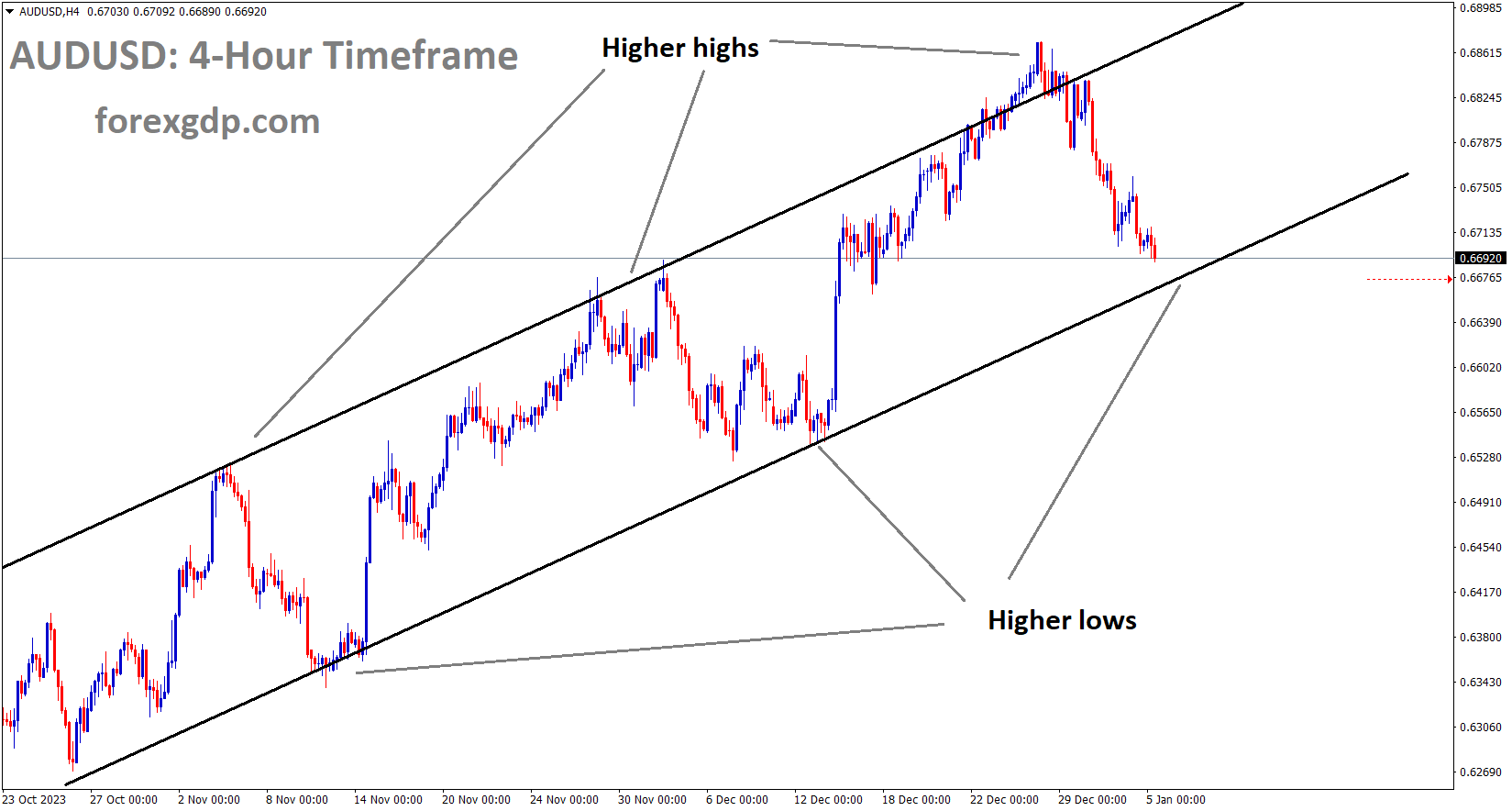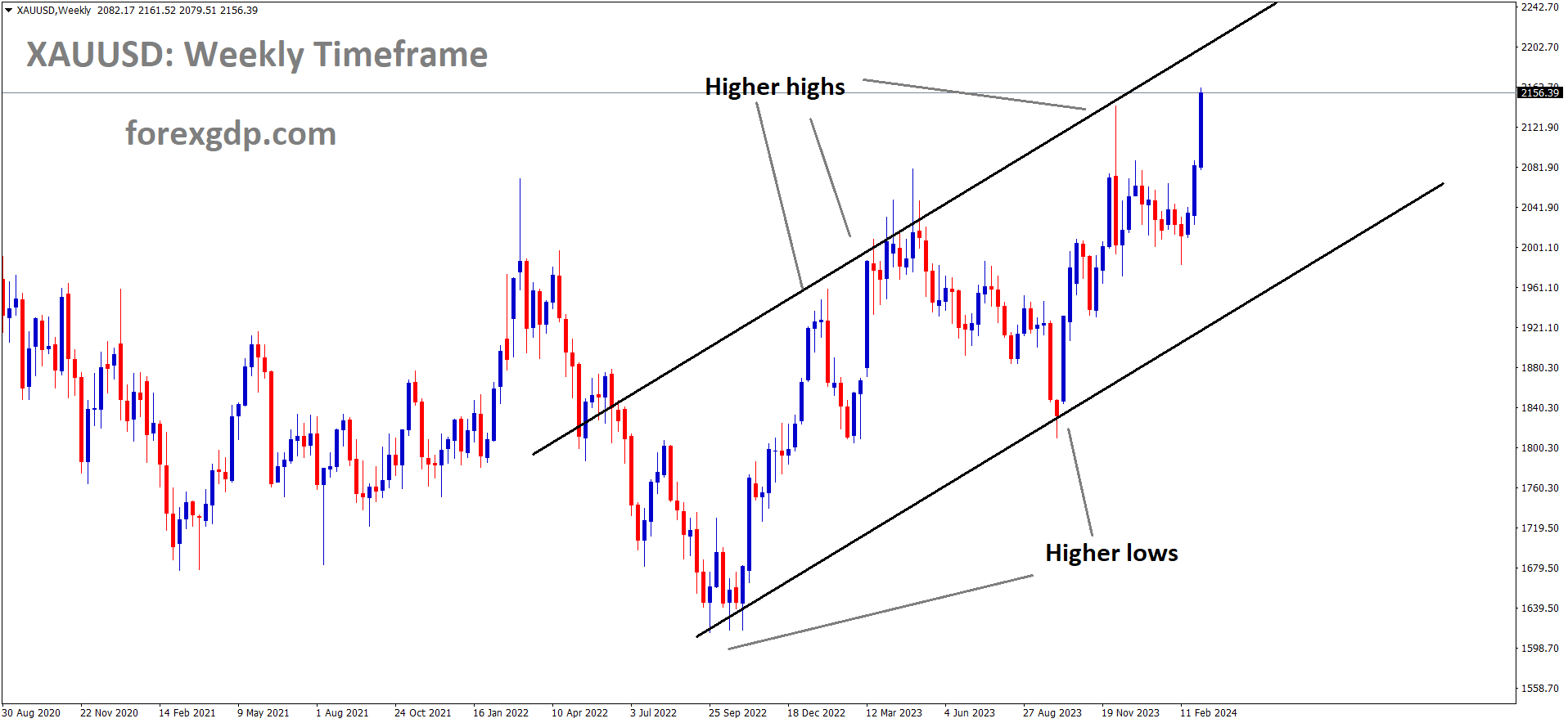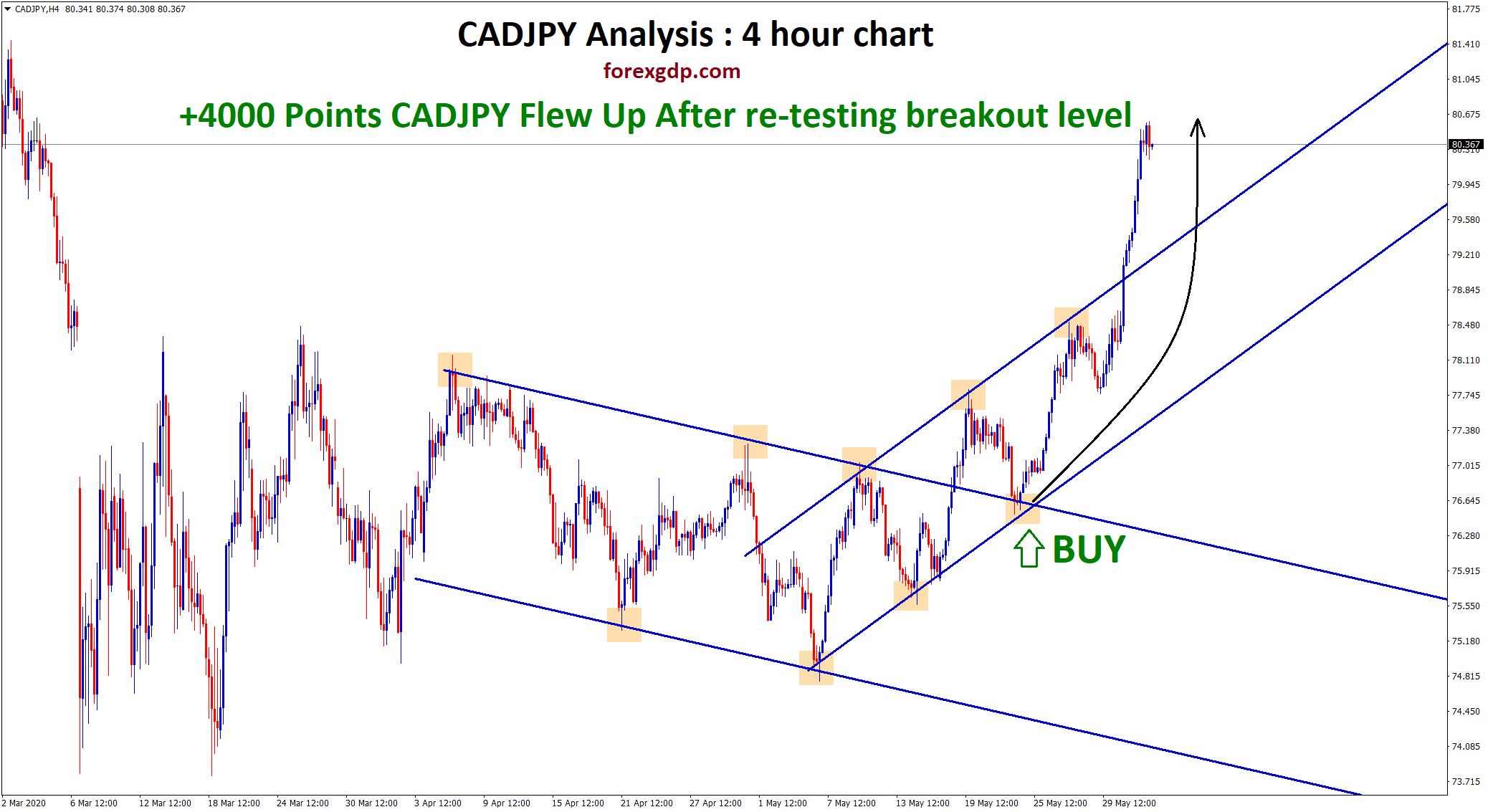AUDUSD Analysis:
AUDUSD is moving in an Ascending channel and the market has reached the higher low area of the channel
Following the reduction in Judo Bank Services and the manufacturing index, the Australian Dollar experienced a decline in its value against the USD. The direction of its movement will be determined further ahead of the release of NFP data today.
The AUDUSD pair is under downward pressure, despite the US Dollar lacking a clear direction and an improvement in China’s Caixin Services PMI in December. The Aussie Dollar’s weakness is influenced by weakened market sentiment and a widespread decline in commodity prices. Australia’s latest Judo Bank Purchasing Managers Index data revealed a contraction in business activities in both the services and manufacturing sectors, emphasizing the Australian Dollar’s vulnerability. Notably, the Services PMI showed the sharpest decline in services since Q3 2021. Nevertheless, Matthew De Pasquale, Economist at Judo Bank, suggests that the slowdown in the Australian economy is not gaining momentum. The US Dollar Index maintains stability, showing a slight inclination toward positive sentiment and potential gains. However, the retracement of recent advances in United States Treasury yields may exert pressure on the Greenback. Additionally, optimistic employment data released on Thursday could be boosting support for the US Dollar.

In December, US ADP Employment Change surged, adding 164K new positions, surpassing both the previous figure of 101K and the market expectation of 115K. Initial Jobless Claims for the week ending on December 29 provided positive signs for the labor market, decreasing to 202K from the previous 220K, beating the anticipated 216K. However, the S&P Global Composite PMI for December reported a minor dip in business activities, registering a reading of 50.9 compared to the market consensus of a steady 51.0. Traders are eagerly awaiting more crucial data from the US employment market, including Average Hourly Earnings and Nonfarm Payrolls (NFP) data for December. Additionally, the ISM Services PMI is set to reveal the current conditions within the US service sector. Australia’s Judo Bank Services PMI reported a reading of 47.1, falling short of market expectations that it would remain consistent at 47.6. The Composite PMI decreased to 46.9 from the previous figure of 47.4. Australia’s Judo Bank Manufacturing PMI indicated a modest contraction in manufacturing activity, declining to 47.6 in December from the previous reading of 47.8. RBA’s internal documents revealed a decline in domestic tourism demand. Furthermore, consumers are reported to be shifting to more affordable products or reducing their overall purchases due to cost-of-living pressures. However, the documents suggest that private sector wage growth has stabilized at around 4.0%.
AUDCHF Analysis:
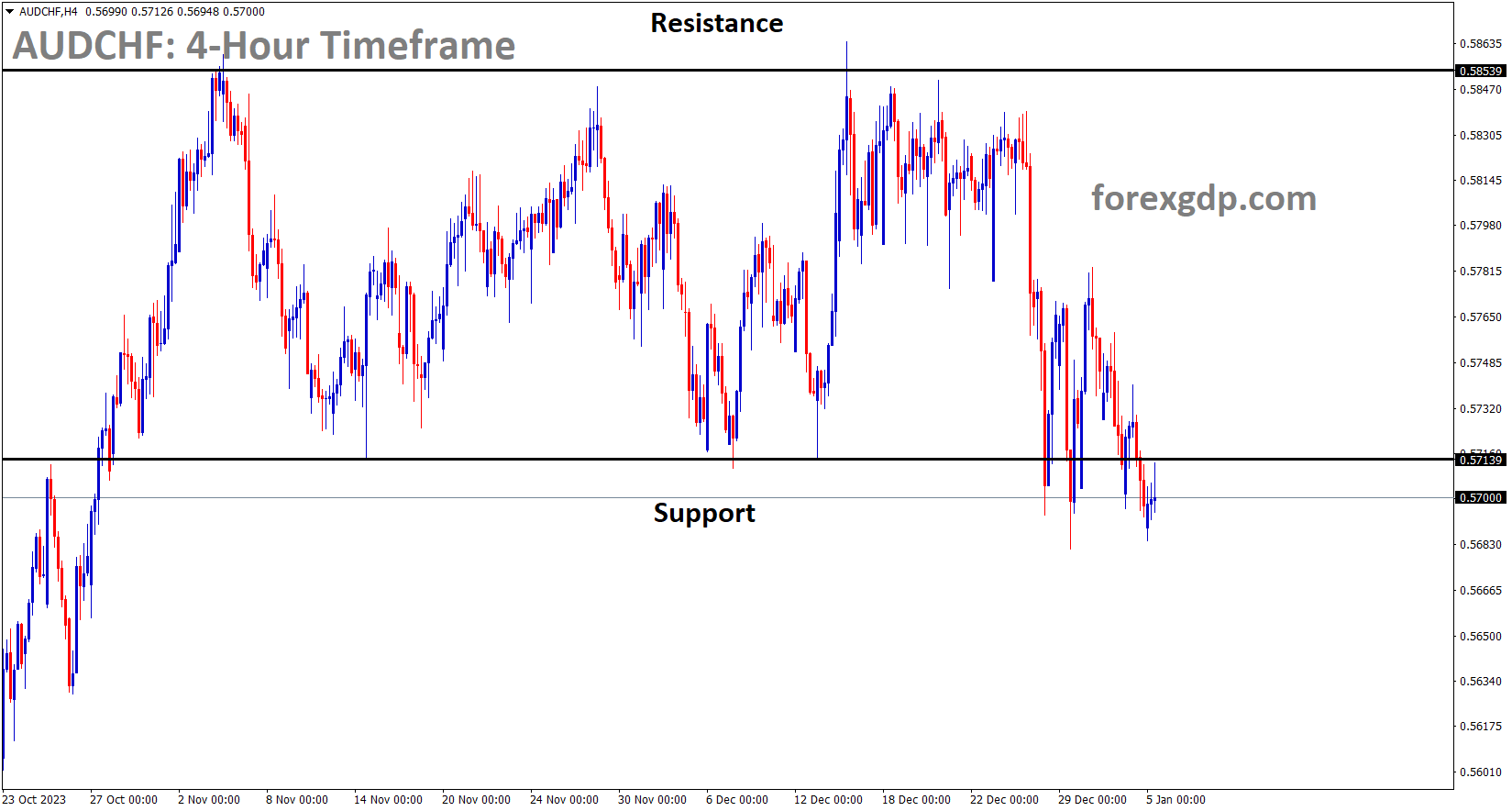
AUDCHF is moving in the Box pattern and the market has reached the support area of the pattern
Australian Prime Minister Anthony Albanese has announced that he has instructed Treasury and Finance to explore measures that can alleviate the financial burden on families in terms of the cost of living without adding to inflation pressures. China’s Caixin Services PMI rose to 52.9 in December, surpassing the expected 51.6 and the previous 51.5. The December minutes from the Federal Open Market Committee indicate that participants believe the policy rate has either reached its highest point in the current tightening cycle or is very close to it. However, they emphasize that the specific trajectory of the policy will depend on evolving economic conditions. US ISM Manufacturing PMI increased to 47.4 in December from the previous reading of 46.7, exceeding the market consensus of 47.1. US JOLTS Job Openings contracted to 8.79 million, falling short of the expected figure of 8.85 million in November. US ISM Manufacturing Employment Index improved to 48.1 in December from 45.8 in November. US S&P Global Manufacturing PMI posted a lower-than-expected figure of 47.9, deviating from the anticipated consistency at 48.2.
GOLD Analysis:
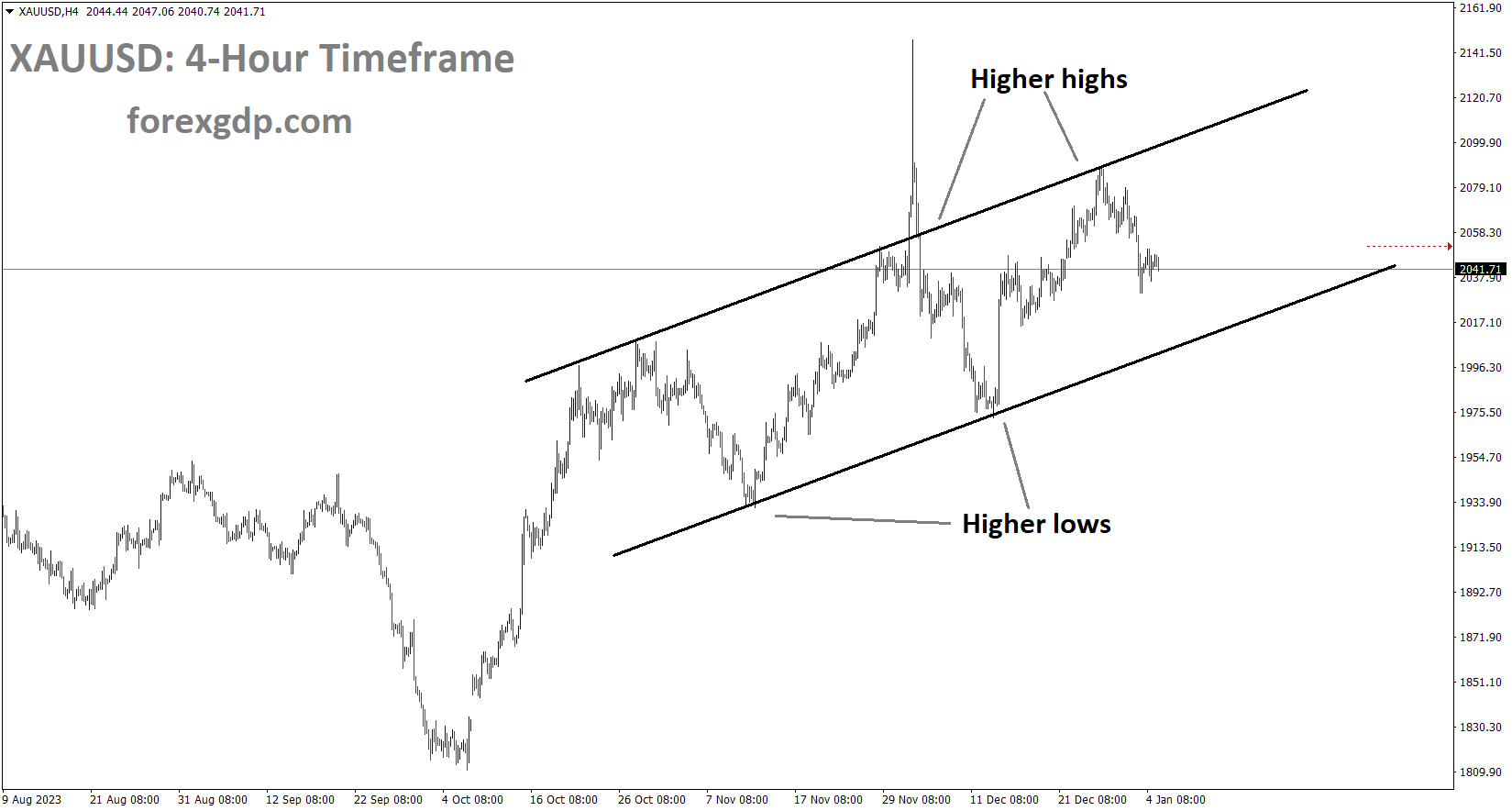
XAUUSD Gold price is moving in an Ascending channel and the market has fallen from the higher high area of the channel
Gold prices are sliding against the USD in response to another strong performance in the US labor market reported yesterday. Investors are now less optimistic about potential rate cuts from the Federal Reserve, given the robust job numbers from yesterday.
The price of gold continues to move sideways as traders adopt a cautious stance, awaiting further clarity from the upcoming US Nonfarm Payrolls report. This report is expected to shed light on the Federal Reserve’s future policy decisions, which in turn will provide a new direction for the non-yielding gold market. In the meantime, investors are revising their expectations for aggressive policy easing by the Fed following the release of positive US labor market reports on Thursday. This has led to elevated US Treasury bond yields and strengthened the US Dollar, limiting the potential gains for gold.
However, the overall cautious sentiment in the market is supporting gold’s status as a safe-haven asset as the key data release approaches. Nevertheless, the XAUUSD remains close to a one-and-a-half-week low reached on Wednesday, suggesting the possibility of registering losses for the first time in the past four weeks.

Geopolitical risks and concerns about China’s economic situation are still weighing on investor sentiment, offering some support to the safe-haven appeal of gold on Friday. The 10-year US Treasury yield remains stable near 4.0%, as expectations for multiple rate cuts by the Federal Reserve have diminished, which is capping the gains in XAUUSD. Traders have reduced their expectations for the number of rate cuts by the Fed in 2024, lowering it from six to four after the release of positive US economic data on Wednesday.
On Thursday, the Automatic Data Processing report revealed that US private-sector employers added 164K jobs in December, surpassing the expected 115K. Additionally, the US Department of Labor reported that Weekly Jobless Claims fell more than anticipated, reaching 202K last week.
Meanwhile, US Dollar bulls appear cautious and are waiting for the release of the highly anticipated official US monthly jobs data, known as the Nonfarm Payrolls (NFP) report. The NFP report is expected to show that the economy added 170K new jobs in December, compared to 199K in the previous month. The unemployment rate is predicted to edge higher to 3.8% from 3.7%, while Average Hourly Earnings growth is expected to ease to a 3.9% YoY rate from 4.0% in November. These crucial employment figures will guide the Fed’s near-term policy outlook, influencing the US Dollar and providing new momentum for the gold market.
USDCHF Analysis:
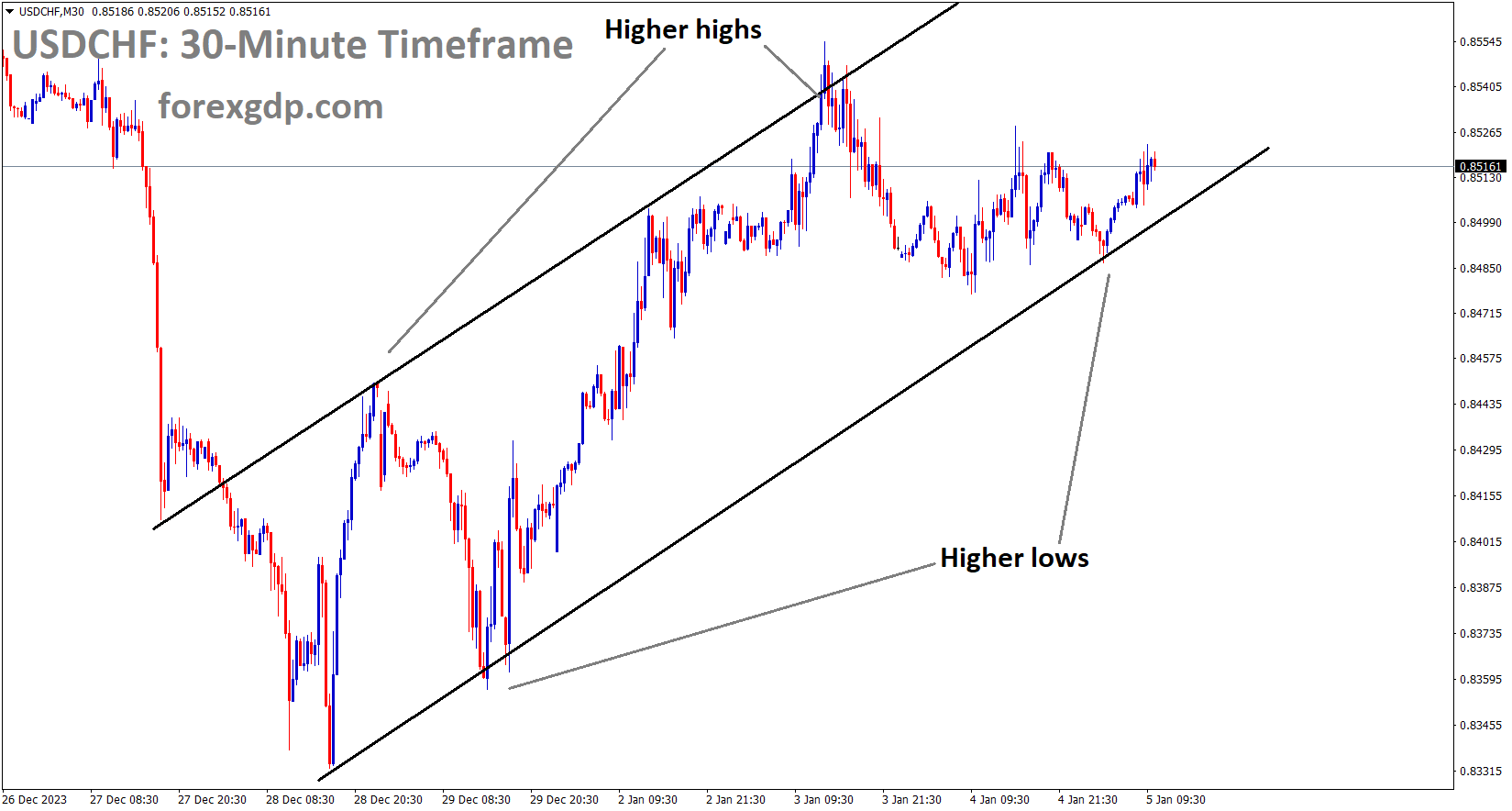
USDCHF is moving in an Ascending channel and the market has rebounded from the higher low area of the channel
Tomorrow, Swiss CPI and Retail sales data are on the agenda, with the Swiss National Bank (SNB) looking to intervene in the market in the hopes of bolstering the Swiss Franc’s performance against its counterpart currencies.
USDCHF is continuing to advance for the second consecutive session, driven by a stronger US Dollar. This USD strength can be attributed to a prevailing risk-off sentiment due to concerns about sluggish global growth at the close of 2024. The US Dollar Index is benefiting from improved US Treasury yields, and the recent positive labor market data from the United States has further supported the US Dollar, helping it to limit its losses.
The employment landscape in the US for December has shown significant improvement, with the ADP Employment Change report revealing the addition of a substantial 164K new positions. This figure surpasses both the previous reading of 101K and the market’s expectation of 115K. Additionally, Initial Jobless Claims for the week ending on December 29 displayed a decrease in claims for unemployment benefits, dropping to 202K from the previous 220K and surpassing the anticipated 216K. Traders are anxiously awaiting further data releases from the US employment market, with a particular focus on key indicators such as Average Hourly Earnings and Nonfarm Payrolls data for December.

Conversely, the Swiss Franc (CHF) has shown resilience against losses, possibly due to interventions in the foreign exchange market by the Swiss National Bank (SNB). Furthermore, the release of the SVME Manufacturing Purchasing Managers Index (PMI) for December on Wednesday indicated improvement, with the figure rising to 43 from the previous 42.1. This positive shift in business conditions within the manufacturing sector may be influencing a more favorable sentiment towards the Swiss Franc.
Traders are now awaiting significant data releases from Switzerland, including the Consumer Price Index and Real Retail Sales, scheduled to be unveiled on Monday. These releases hold the potential to provide vital insights into the economic health of Switzerland and may impact market sentiment, thereby guiding trading decisions in the USDCHF pair.
EURUSD Analysis:
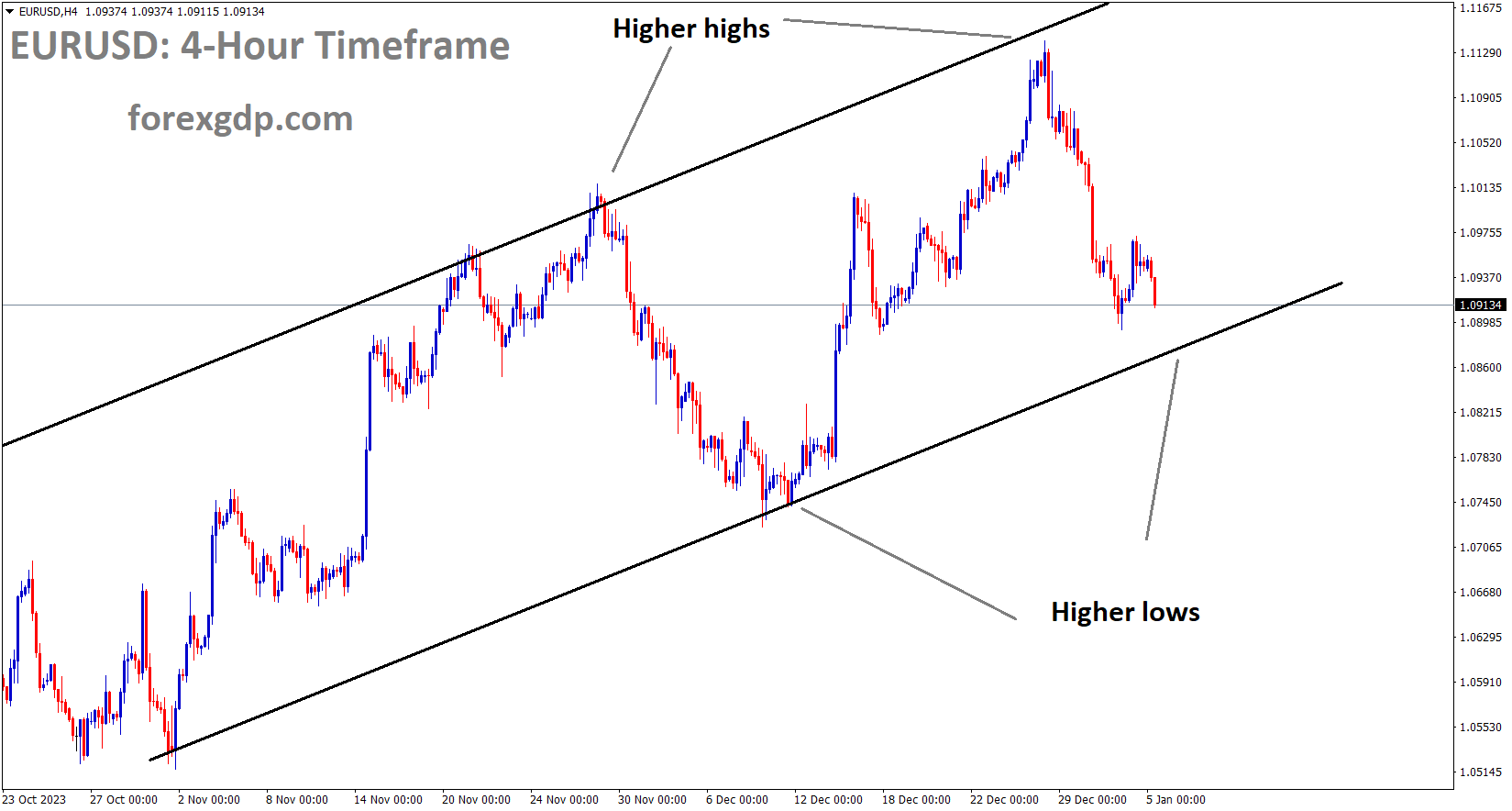
EURUSD is moving in an Ascending channel and the market has reached the higher low area of the channel
In December, German CPI data showed a reading of 3.8%, surpassing the previous month’s figure of 3.2%. As a result of this data, the Euro has appreciated. The European Central Bank (ECB) is expected to keep interest rates unchanged due to inflation exceeding expectations.
The major currency pair remains relatively stable as the preliminary German Harmonized Index for Consumer Prices for December met expectations. The monthly HICP showed a slightly slower growth rate of 0.2%, compared to the consensus forecast of a 0.3% increase. In November, there was a contraction in price pressures by 0.7%. The annual HICP reached 3.8%, in line with expectations and higher than the earlier growth rate of 3.2%. This may lead European Central Bank policymakers to maintain their current stance of keeping interest rates unchanged. In the European session, S&P500 futures have seen significant gains. US equities experienced notable sell-offs in the last two trading sessions, and the substantial gains in overnight futures suggest a potential recovery in market participants’ risk appetite.

The US Dollar Index has corrected to 102.20 following a sharp rebound, as investors exercise caution ahead of the release of the United States ADP Employment Change data for December at 14:00 GMT. According to consensus estimates, the labor market is expected to have added 115K new workers, compared to 103K additions in November. Meanwhile, the likelihood of rate cuts by the Federal Reserve this year has increased, as the minutes from the Federal Open Market Committee’s December monetary policy meeting revealed concerns among policymakers about the potential ‘over-tightening’ of interest rates.
GBPUSD Analysis:
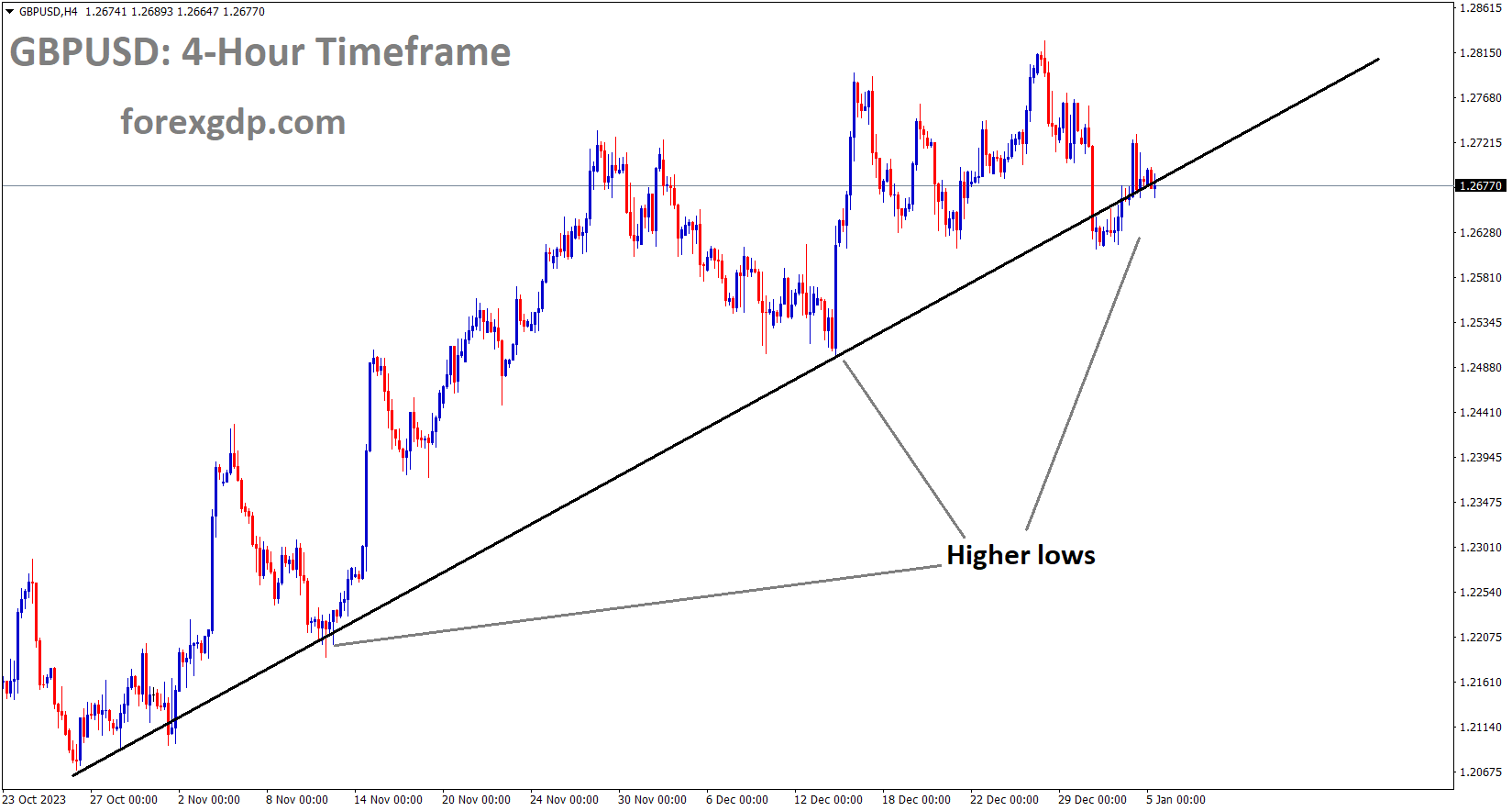
GBPUSD is moving in an Up-trend line and the market has reached the higher low area of the line
The British Pound weakened as market participants anticipated a mild recession in the UK economy. The credit and household constraints resulting from the Bank of England’s higher interest rates may possibly be mitigated through policy measures in the first half of 2024, compared to measures taken previously.
The Pound Sterling is encountering selling pressure as market sentiment has soured following the release of robust private employment data for December from the United States. The US Automatic Data Processing report showed that private payrolls increased by 164K, surpassing the consensus estimate of 115K and the previous reading of 103K. A resilient labor market in the US could lead Federal Reserve policymakers to support higher interest rates for an extended period. Despite concerns about potential rate cuts by the Fed, the overall outlook for the GBPUSD pair remains positive, as the Bank of England continues to emphasize the need for a prolonged period of higher interest rates. Additionally, the Pound Sterling’s recovery has been bolstered by encouraging S&P Global UK Composite and Services PMI figures. Both the Composite and Services PMI, at 52.1 and 53.4 respectively, exceeded expectations of 51.7 and 52.7.

However, pressure on the Pound Sterling could intensify if fears of the United Kingdom slipping into a mild recession heighten. The economic outlook appears gloomy due to challenging conditions related to credit and household demand, potentially leading BoE policymakers to reconsider their restrictive monetary policy stance earlier than anticipated. The Pound Sterling’s recovery has faltered in the wake of the upbeat US labor market data, which has dampened overall market sentiment. The improved labor market conditions could sustain the expectation of higher interest rates for longer. Earlier, the market sentiment of investors had improved following the release of the Federal Reserve’s FOMC minutes, which indicated that policymakers were cautious about implementing an overly restrictive monetary policy.
While the Fed minutes suggested the possibility of interest rate cuts, the timing remains uncertain. Fed policymakers expressed confidence in controlling inflation without triggering a recession. Meanwhile, the Pound Sterling is facing downward pressure from the combination of domestic uncertainties in the UK and a pessimistic market mood. S&P Global reported this week that the UK’s Manufacturing PMI dropped to 46.2, slightly below the preliminary reading of 46.4, signaling the impact of high inflation and interest rates both domestically and internationally. Business optimism in the UK has declined due to soft orders amid an escalating cost-of-living crisis. Business investment remains lackluster due to elevated borrowing costs. The UK economy is vulnerable to a technical recession after a 0.1% contraction in Gross Domestic Product in the third quarter of 2023, with a significant likelihood of another decline in the fourth quarter. In its latest projections, the Bank of England indicated it does not anticipate any growth ahead. The BoE faces the challenge of balancing efforts to prevent the economy from slipping into a recession while addressing persistently high inflationary pressures. Underlying inflation in the UK exceeds the targeted rate of 2%, compelling policymakers to maintain a restrictive monetary policy stance. Meanwhile, the US Dollar Index is staging a recovery, approaching 102.50, as investors seek safe-haven assets amid a shift towards risk aversion in the market.
GBPJPY Analysis:
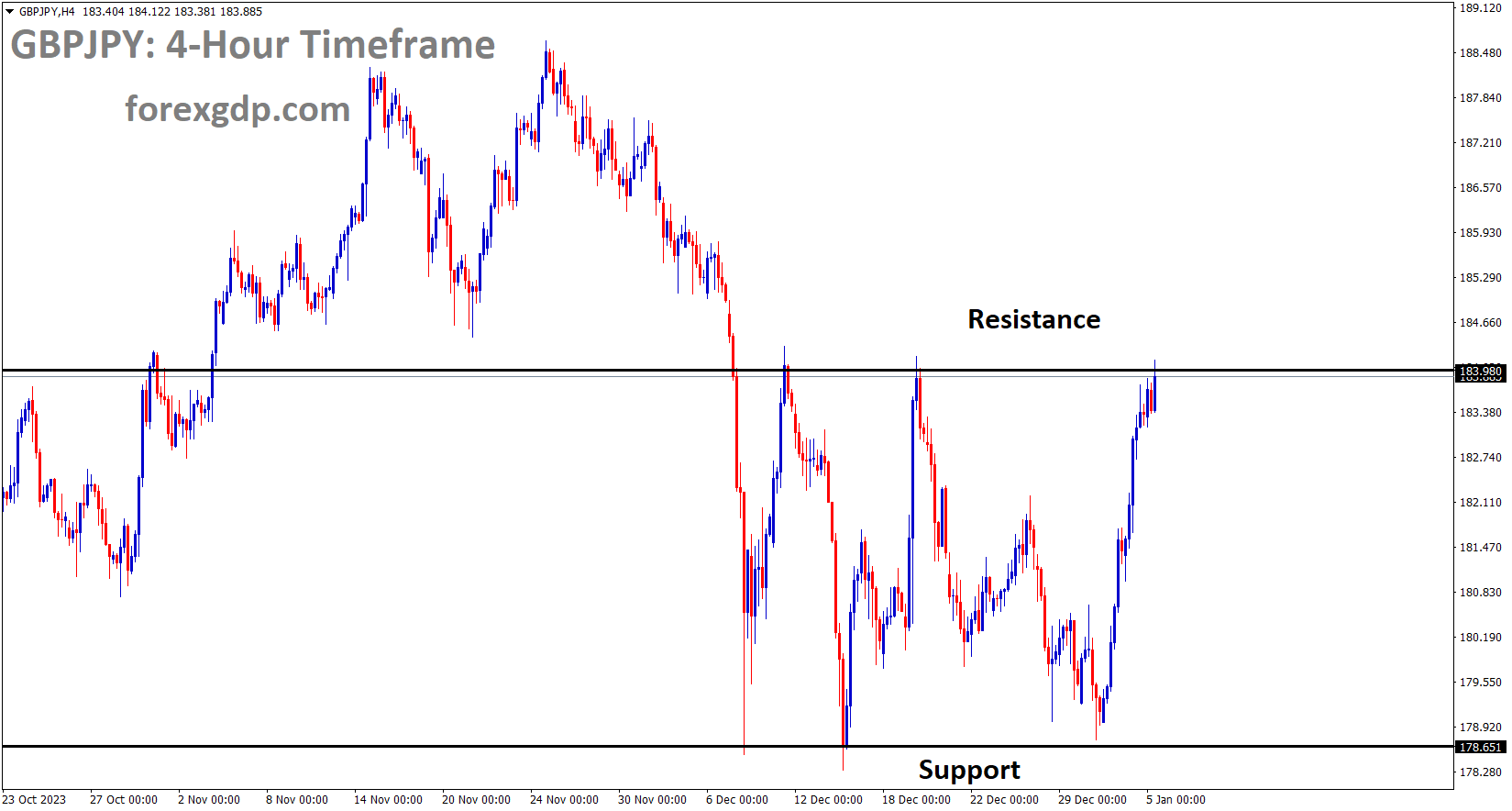
GBPJPY is moving in the Box pattern and the market has reached the resistance area of the pattern
The growth of the Japanese monetary base decreased to 7.8% in December, down from 8.9% the previous month.
The year-on-year growth of Japan’s Monetary Base for December registered a decrease, reaching 7.8%, which fell short of the median market predictions of 9%.

]This figure also represents a further decline from November’s annualized reading of 8.9%. When accounting for seasonal adjustments, the Monetary Base exhibited a significant decline, with a 14.5% decrease after adjusting for cyclical factors.
GBPNZD Analysis:
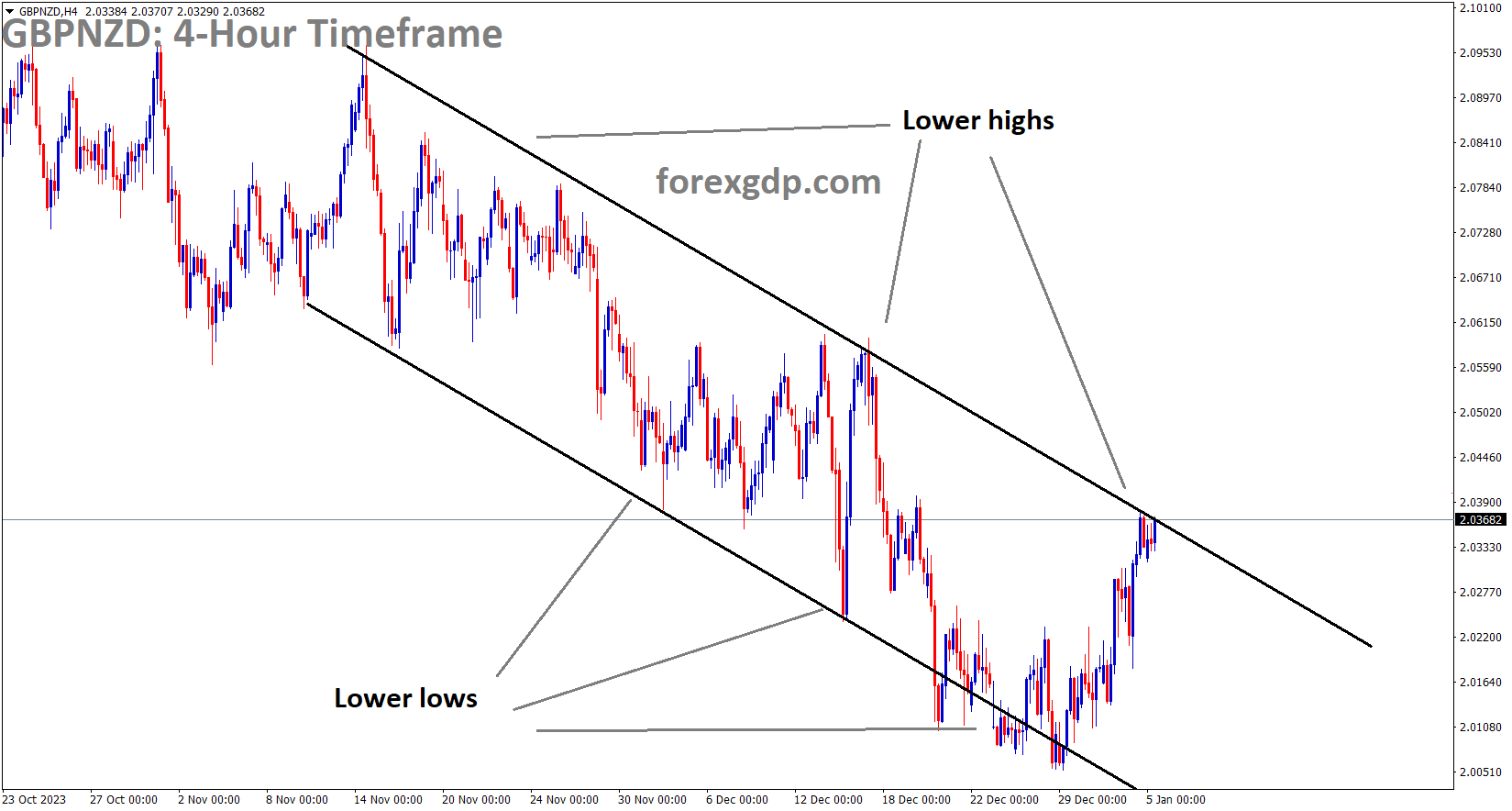
GBPNZD is moving in the Descending channel and the market has reached the lower high area of the channel
Chinese Services Purchasing Managers’ Index (PMI) figures have surpassed expectations, but a surge in US labor and jobless claims has prompted investors to retreat to familiar midranges in anticipation of Friday’s US Nonfarm Payrolls labor report. China’s Caixin Services PMI rebounded to 52.9 in December, exceeding the forecasted increase from November’s 51.5 to 51.6.

Alongside China’s better-than-expected performance in the Manufacturing component of the Caixin PMIs, the risk appetite in the Asian market session firmly shifted to a risk-on mode.
GBPCAD Analysis:
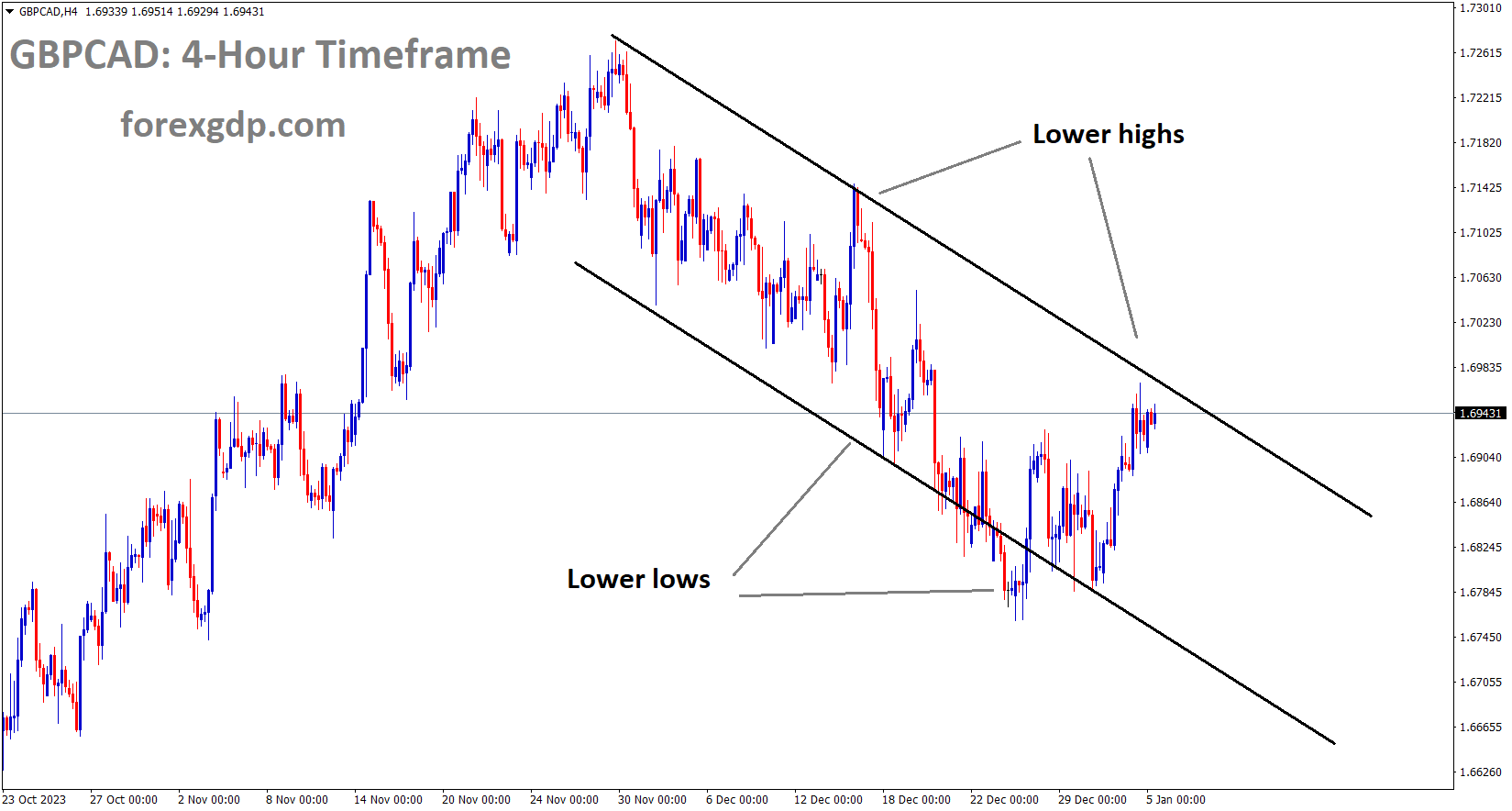
GBPCAD is moving in the Descending channel and the market has reached the lower high area of the channel
The Canadian Dollar has weakened against its counterpart currencies in anticipation of today’s release of the Canadian employment change and unemployment rate data. However, the Canadian Dollar could find support in the form of rising crude oil prices.
The Canadian Dollar, often referred to as the Loonie, may benefit from the improvement in crude oil prices. The West Texas Intermediate price has rebounded from recent losses and is currently trading at around $72.70 per barrel. However, WTI has faced some downward pressure due to an increase in US gasoline and distillate inventories, which has raised concerns about demand stability. Canada is preparing to release crucial economic data, including the Unemployment Rate and Net Change in Employment figures for December on Friday.
CRUDE OIL Analysis:
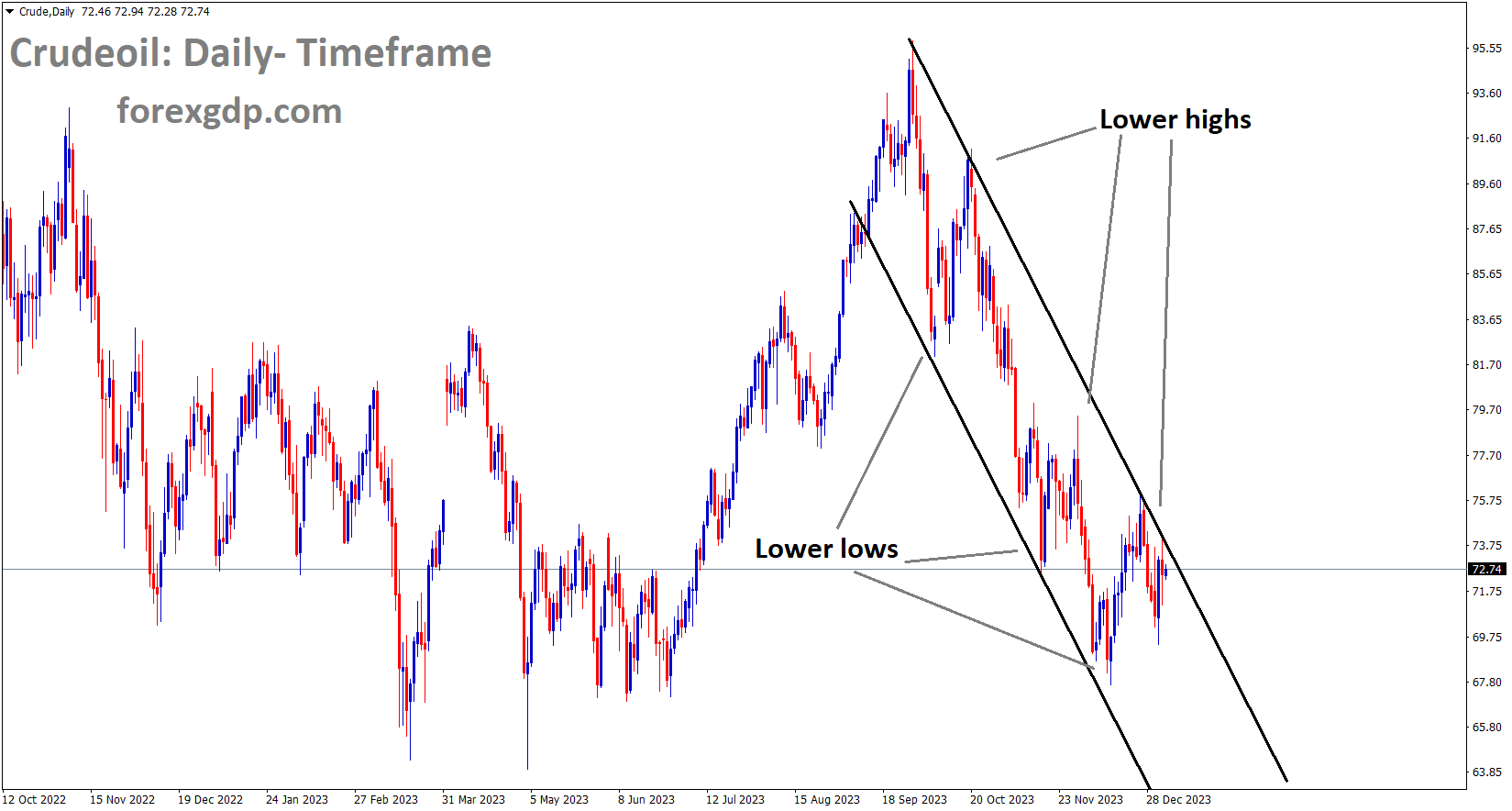
Crude Oil Price is moving in the Descending channel and the market has reached the lower high area of the channel
Houthi rebels have once again ignited conflict in the waterways near Yemen. This ongoing conflict is causing an increased number of commercial ships to reroute to the African side, resulting in longer delivery times for goods destined for Europe and Asia.
West Texas Intermediate US Crude Oil experienced a decline on Thursday, despite a reduction in Crude Oil supplies. Data from the Energy Information Administration (EIA) revealed that gasoline reserves saw a significant increase. Crude Oil had risen on Wednesday due to ongoing attacks by Iranian-backed Houthi rebels on ships in critical maritime routes near Yemen. Additionally, energy investors remained concerned about potential supply disruptions between Europe and Asia, as ships initially destined for the Suez Canal were diverted around the African continent, resulting in extended shipping times for already-loaded goods. Despite these factors, the actual state of global Crude Oil supply contradicts market fears of hypothetical supply constraints, particularly as US refined gasoline supplies continue to grow.

The EIA reported a 5.5 million barrel decrease in US Crude Oil reserves for the week ending December 29, surpassing the forecasted decline of 3.7215 million barrels. This reduction follows the previous week’s drawdown of 7.114 million barrels. However, the surge in EIA refined gasoline reserves by nearly 11 million barrels, compared to the market’s expected decline of 1.67 million barrels and the previous week’s drawdown of 6769K barrels, has had a dampening effect on Crude Oil prices.
The substantial increase in gasoline product stockpiles has placed downward pressure on Crude Oil, as the global production of fossil fuel products continues to contribute to supply surpluses. This has led to a tempering of expectations for future purchases. In an effort to boost immediate demand for barrels, the Organization of the Petroleum Exporting Countries released a statement in conjunction with non-OPEC Declaration of Cooperation countries. This statement reaffirmed OPEC’s commitment to “market stability,” a signal often used by OPEC to convey their intention to significantly undersupply global oil markets. However, with global oil demand showing signs of decline and reserves accumulating at a faster rate than expected, investors are increasingly skeptical about OPEC’s ability to persuade more of its member states to reduce oil production further. Many of these countries rely heavily on Crude Oil sales to support their government budgets, adding complexity to the situation within the OPEC cartel itself.
Don’t trade all the time, trade forex only at the confirmed trade setups.
Get more confirmed trade setups here: forexgdp.com/buy/

